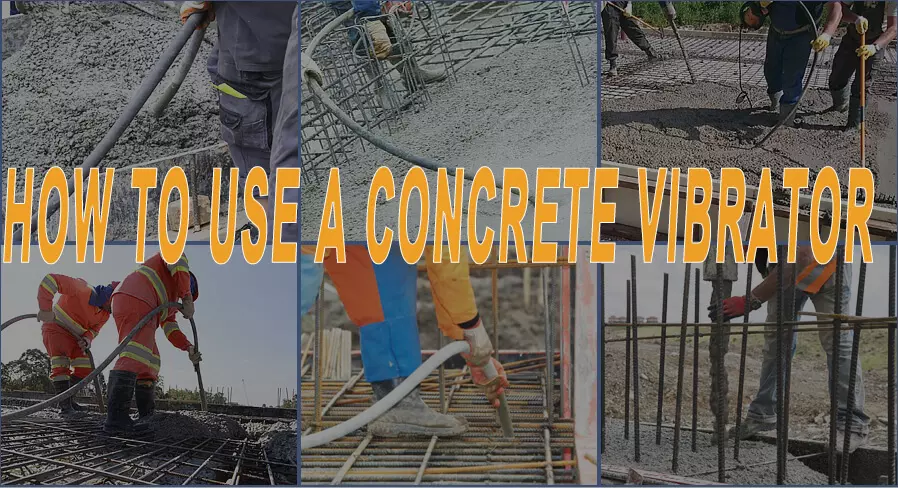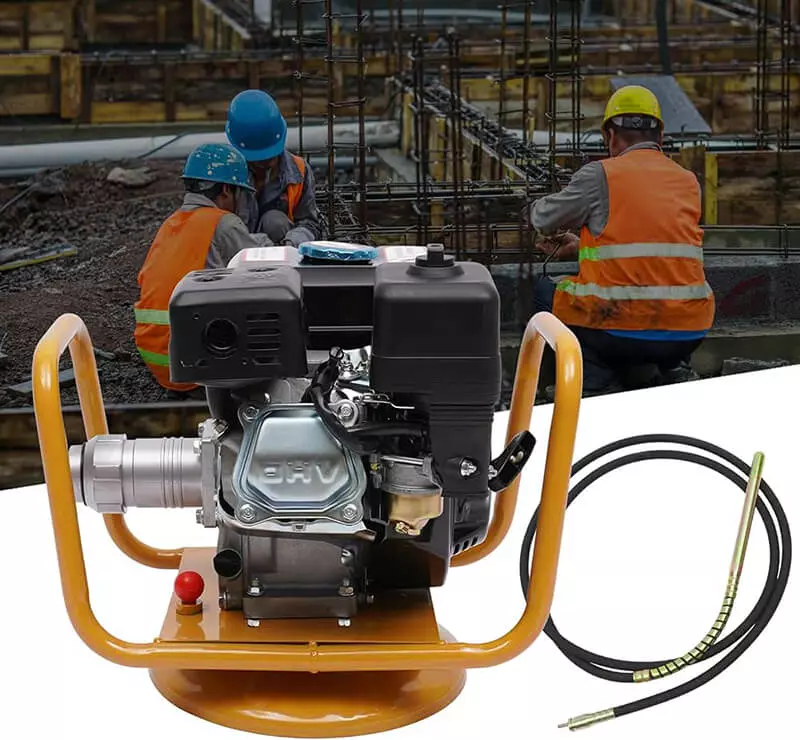16Dec 2023
table of contents

Vibration is one of the methods used to strengthen poured concrete to achieve the desired density and, subsequently, the specified concrete strength. Vibrators (internal, external or shutter) must be used correctly and skillfully; otherwise, the concrete may be over-vibrated or under-vibrated; in both cases, the concrete quality will be affected.
That's why it's worth considering practical tips and field experience to use a concrete vibrator and achieve vibration goals properly.
Concrete vibrators come in different forms and shapes and can be pneumatic or electric. Concrete vibration applications can be divided into three basic categories:
The formwork vibration is commonly used in precast concrete construction and involves mounting vibrators to the exterior of the concrete form. For larger pours, external vibrators are typically spaced 6 feet apart.
With surface vibration, large vibrators are manually directed onto the surface where the concrete is poured. This method is limited to slab depths of about 6 inches or less, but provides a smooth finish, which is especially desirable when appearance is important.
Internal concrete vibrators are the most commonly used type. One operator can handle many. The process is relatively simple: Workers quickly insert a probe-like internal vibrator into the wet concrete, then slowly remove it.
Poker, immersion, or needle vibrators are the most used names for internal vibrators. The internal vibrator's head is submerged in the concrete, compacting it with vibration pulses.
Use the small head to compact concrete with shallow formwork or closely spaced rebar and the large head vibrator to reinforce concrete cast with a comprehensive formwork and widely spaced rebar.
The radius of influence of the vibrator head is equal to four times the diameter of its head. Consequently, small-head vibrators must be inserted into the concrete at smaller intervals than large vibrator heads.
Determine the radius of influence at the site by noting how far air bubbles in the concrete escape from the vibrator head. Instead, employ an estimated distance ranging from 1 to 1.5 times the radius of influence.
Immerse the vibrator into the concrete using square or offset patterns. However, use one vibration pattern throughout your work.
For the former case, insert the vibrator apparatus in a rectangular grid, ensuring that 1/3 of the radius of influence overlaps.
For offset patterns, use a grid pattern but position the vibrator heads in a zigzag fashion.
Do not operate the vibrator in the air; be sure to turn it on while its tip is in the concrete to prevent overheating of the instrument and subsequent damage.
Insert the vibrator head vertically or nearly vertically into the concrete, and do not tilt the vibrator excessively; otherwise, it will be damaged. Vertical vibrators help air bubbles escape and reduce voids.

Please do not force the vibrator into the concrete, as the rebar may block it. Instead, let the vibrator penetrate the concrete under its weight.
Avoid hitting the rebar with the vibrator head, as it will break the bond between the rebar and the first few layers of reinforced concrete.
Hold the vibrator head in the concrete for 15-20 seconds. However, workers with sufficient experience with vibrators, concrete mixes, and forms can properly reinforce concrete regardless of the vibration duration. Slowly exit the vibrator at a rate of about 2.5-7.5 cm/s; the smallest range usually provides the best results.
Concrete should fill the hole formed after the vibrator is withdrawn. However, the voids are not filled with concrete from the dry concrete mix. Reinserting the vibrator into the concrete within one-half of the radius of influence resolved the problem. If the problem persists, replace the concrete blend or vibrator.
Keep a distance of 7-10 cm between the edge of the formwork and the vibrator head to avoid damage to the formwork.
Do not use a vibrator to move concrete.
Avoid excessive vibration to prevent segregation and check the formwork for any leaks throughout the work.
Pour the concrete evenly and widely to a thickness equal to the length of the vibrator's head plus 15 cm. Thickness of the concrete should not exceed 45-50 cm, as in the case of large pads and foundations; otherwise, the weight of the concrete will prevent trapped air from being released to the surface. When pouring concrete in layers, extend the vibrator into the upper layer by 10-15 cm, and move the vibrator up and down for 5 to 15 seconds to improve the bonding between layers.
Use a sufficient number of vibrators to handle the speed of concrete placement.
Continue vibrating until the concrete level in the formwork; coarse aggregate particles are embedded, a film of mortar forms on the top and formwork surfaces, and the concrete stops bubbling.
The vibrator operator should see the concrete surface. So use lighting if necessary.
The frequency of the vibrator decreases initially when immersed in the concrete, then increases, and finally becomes constant when the air bubbles escape.
Have a spare vibrator on site. Use it when one of the vibrators completely fails.
Workers should be instructed to avoid vibrating concrete that has already been vibrated.
Clean all vibrator parts after each use.
External concrete vibrators are suitable for constructing precast concrete products and thin walls. They are effective to a maximum depth of 75 cm (18 in).
Zero-slump concrete and supplemental internal vibrators require shutter or formwork vibrators.
Ensure good support to formwork to avoid failure due to external vibrator application.
The forms should withstand the pressure from the liquefied concrete and vibrators. Moreover, it should possess the capability to transmit vibrational forces across substantial distances.
Vibrators with low frequency and high amplitude have a more substantial impact on the formwork compared to those with high frequency and low amplitude. Consequently, when employing a low-frequency, high-amplitude vibrator, ensure the formwork is robust, such as using steel formwork.
Distributed shutter vibrators ensure uniform distribution of vibration force. Use your hand or a vibrator on the formwork to determine the limit of the vibrator’s action and the proper spacing to distribute the vibrating power evenly. This avoids areas of excessive vibration or regions of low vibration.
Do not attach the vibrator directly to the formwork, as this will cause the formwork to fail.
Do not switch on the external vibrator until the concrete in the formwork has reached a depth of 15 cm.
Typically, the external vibrator runs for two minutes. Afterwards, the duration can be increased or decreased as desired.
When the concrete in the formwork is level, the vibration is stopped, the coarse aggregate particles are embedded, a mortar film is formed on the top surface, and the formwork surface and the concrete eliminates air bubbles.

Honeycomb structures can be avoided.
Structures with heavy reinforcement can be easily compacted.
The structure prepared by the vibrator is dense and watertight.
The low water-cement ratio can be used.
Work faster.
A high aggregate cement ratio can be used.
If the concrete mixture is designed with low workability, excessive vibration can cause additional power consumption and, thus, energy dissipation.
Although concrete mixtures require small amounts of air, larger voids can significantly negatively impact concrete strength and durability. Concrete vibration allows more oversized air pockets to rise to the surface while leaving useful microscopic air particles in the mix.
Air pockets larger than one millimeter create voids in the concrete, often called honeycombing. Honeycombing inhibits the concrete’s ability to bond correctly with the rebar. The less contact the cement mixture has with the steel reinforcement, the lower the strength of the dry concrete.
Inadequate vibrating of concrete can result in surface defects, the most common of which are air pockets.
As the concrete surface sets, air bubbles emerge from the mix, causing blistering. They look like fragile bumps on the surface that break, often leaving a small cavity underneath.
If the concrete is not adequately reinforced in framings, such as columns or walls, the mix will not flow ultimately against the edges, and honeycomb areas will develop in the mix. After removing the frame, honeycomb areas lead to structural weakness and surface defects, such as cavities.
Mastering the proper use of concrete vibrators is crucial to achieving strong, durable and well-structured concrete structures. The benefits of using a concrete vibrator are evident in terms of the quality of the final product, the reduction of pores and the overall increase in strength.
BISON concrete vibrator ensures optimal consolidation of concrete, enabling projects to meet industry standards for long-term durability. To choose a concrete vibrator that suits your specific needs, please feel free to consult the experts at BISON.
Concrete consolidation reduces the volume of entrapped air, voids and air pockets in a freshly placed cement mixture, usually using concrete vibrators.
Operating the poker or internal vibrator in the air can cause overheating and subsequent instrument failure.
Keep a distance of 7-10 cm between the edge of the formwork and the vibrator head to avoid damage to the formwork.
Continue vibrating until the concrete level in the formwork; coarse aggregate particles are embedded, a film of mortar forms on the top and formwork surfaces, and the concrete stops bubbling.
If concrete is over-vibrated, it loses consistency and segregates. The aggregate will settle to the bottom of the formwork, while the cement paste will rise to the top of the elements. As a result, the strength of the concrete is reduced to a honeycomb.
inquiry form here
BISON BLOG, All the latest news and views from Bison Machinery.